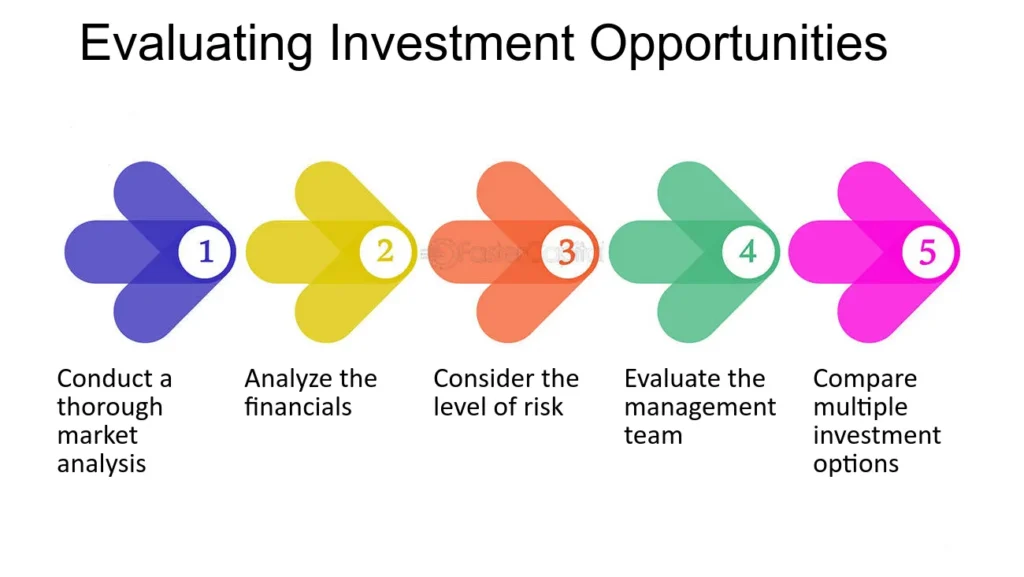Investing wisely requires a careful balance between risk and potential returns. Evaluating investment opportunities effectively is crucial for achieving financial goals and avoiding unnecessary losses. Here’s a comprehensive guide to assessing these factors and making informed investment decisions.
1. Understand Your Investment Goals
Before diving into specific opportunities, it’s essential to define your investment objectives. Are you looking for long-term growth, steady income, or a combination of both? Your goals will influence the types of investments you consider and how you evaluate their potential. For instance, younger investors might focus on growth stocks, while those nearing retirement might prefer bonds or dividend-paying stocks.
2. Assess the Risk Profile
Every investment carries a certain level of risk. Understanding and assessing this risk is crucial. Here are some key factors to consider:
- Volatility: This measures how much the investment’s price fluctuates. High volatility means greater potential for large gains or losses. Stocks and cryptocurrencies, for example, tend to be more volatile than bonds or savings accounts.
- Credit Risk: For fixed-income investments like bonds, credit risk refers to the possibility that the issuer might default. Checking the issuer’s credit rating from agencies like Moody’s or S&P can help gauge this risk.
- Market Risk: This encompasses the broader economic factors that could affect the investment’s performance, such as economic downturns or changes in interest rates. Diversification across different asset classes can mitigate market risk.
3. Analyze Potential Returns
Evaluating potential returns involves looking at historical performance and future projections:
- Historical Performance: While past performance doesn’t guarantee future results, it provides insight into how the investment has behaved under various market conditions. Compare the performance of similar investments to gauge relative potential.
- Expected Returns: Analyze financial projections and valuations. For stocks, this might include earnings growth, price-to-earnings (P/E) ratios, and analyst forecasts. For real estate, consider rental income potential and property appreciation trends.
- Dividend Yields: For income-focused investors, the dividend yield is crucial. This represents the annual dividend payment divided by the stock’s current price. A higher yield might indicate attractive income potential, but it’s important to ensure the company can sustain its dividend payments.
4. Evaluate the Investment’s Fundamentals
A thorough assessment of an investment’s fundamentals helps ensure its long-term viability:
- Financial Health: For companies, review financial statements including income statements, balance sheets, and cash flow statements. Key metrics such as debt-to-equity ratio, return on equity (ROE), and profit margins provide insights into financial stability.
- Industry Position: Assess the investment’s position within its industry. Is it a leader or a follower? What are its competitive advantages, such as patents, brand strength, or cost efficiencies?
- Management Quality: Evaluate the experience and track record of the management team. Effective leadership is crucial for steering the investment towards long-term success.
5. Consider Economic and Market Conditions
Broader economic conditions and market trends can significantly impact investment performance. Stay informed about:
- Economic Indicators: Watch for indicators like GDP growth, unemployment rates, and inflation, which can influence market performance and investment returns.
- Market Trends: Understand current market trends and sector performance. Emerging technologies, regulatory changes, and consumer behavior shifts can create opportunities or pose risks.
6. Diversify Your Portfolio
To manage risk, diversify your investments across different asset classes, sectors, and geographic regions. Diversification helps mitigate the impact of poor performance in any single investment, spreading risk and potentially enhancing overall returns.
Conclusion
Evaluating investment opportunities involves a comprehensive analysis of risk, potential returns, and fundamental factors. By understanding your goals, assessing risk profiles, analyzing potential returns, evaluating fundamentals, considering economic conditions, and diversifying your portfolio, you can make informed investment decisions that align with your financial objectives. Always remember that investing carries inherent risks, and it’s prudent to consult with financial advisors to tailor strategies to your specific needs.


